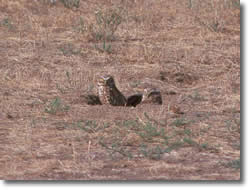Conservation of Burrowing Owls on golf courses in North America
Burrowing Owl populations have declined in many portions of their breeding range. Availability of nesting burrows is one factor thought to limit populations. Throughout their range, Burrowing Owls appear to be attracted to golf courses for foraging. However, the area surrounding golf courses may lack suitable nesting burrows. If golf courses across the range of the Burrowing Owl could install artificial nesting burrows, then the golf courses throughout the western U.S. may be able to contribute to Burrowing Owl recovery. However, attracting Burrowing Owls to nest near golf courses may cause more harm than good if chemicals used by golf courses adversely affect reproduction or survival of nesting owls in the surrounding area. In 2000 and 2001, we installed 130 artificial nesting burrows on 8 local golf courses in eastern Washington and installed 85 artificial nesting burrows in eastern Washington in areas not associated with golf courses. We simultaneously monitored approximately 200 nests in natural burrows (see our project “Population ecology and habitat requirements of Burrowing Owls in eastern Washington”). Owls have only used a small number of these artificial burrows for nesting (2 of 130 in each of 2 years). Five other artificial burrows on golf courses were occupied by unpaired males. The burrows that were used by owls tended to be further from maintained areas (outside of the watered and mowed areas) and close to natural burrows that were already in use by owls. Nesting success has been high in artificial burrows on golf courses (100% of the 4 nests fledged young). However, the number of young fledged per nest was lower in nests associated with golf courses (~2 young per successful nest) compared nests off golf courses (~4 young per successful nest). Nesting near a golf course did not appear to have negative effects on adult survival; adults nesting on golf courses had slightly higher site fidelity across years (55%) compared to adults nesting off golf courses (30%). We hope to continue to monitor these burrows for the next two years.


